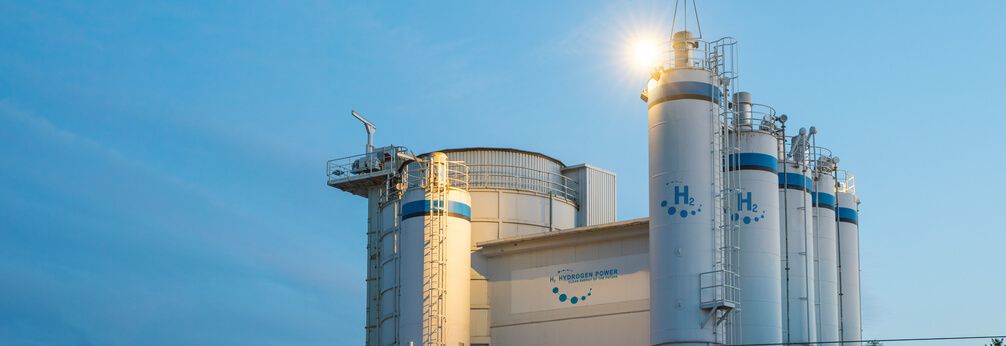The Promise of Tri-Generation Power Plants

Entering a sustainable energy future requires adopting numerous climate change mitigation strategies. One promising strategy currently gaining traction is “co-generation.” This involves integrating electricity production with other power generation or industrial processes to reduce waste and create new efficiencies.
Tri-generation takes the strategy another step further, producing three outputs. By leveraging tri-generation capabilities to provide hydrogen fuel, we can help increase the adoption of one of the most promising and climate-friendly energy sources. Let’s look closer at how tri-generation power plants work, their benefits, and current projects already making an impact.
Understanding Co-Generation: The Basics
Before exploring tri-generation plants and their benefits, it’s helpful to understand the basic principles of co-generation. And for that, temperature control inside gas-powered cars likely provides the most accessible example.
When drivers run the heat in their car, they tap into their engine cooling system. The coolant cycling between the engine and radiator makes a side trip through another, smaller radiator that exchanges its heat with the air blowing into the vehicle. The result improves engine temperature regulation and sends the heated air into your car’s interior.
The hot air that warms drivers and passengers is “co-generated” through a more energy efficient process than separately producing it with electricity or other means.
What is a Tri-Generation Plant?
Tri-generation plants produce three outputs through co-generation. They achieve this by integrating industrial processes, chemical reactions, and their resulting waste.
Typically, the three outputs are electricity, heat, and cooling. However, they can be any energy source or usable product that would otherwise require energy and produce additional waste, like hydrogen.
For example, the following processes are integrated at the Fountain Valley tri-generation plant in California to produce electricity, hydrogen, and heat:
- Biogas is fed into a fuel cell to produce electricity through a chemical reaction, which also generates hydrogen and heat as byproducts.
- Most of the resultant heat gets exchanged to assist other processes (e.g., temperature control, hot water, industrial processes) instead of using another energy source.
- The hydrogen produced is either reused within the system or purified for use as fuel (e.g., fuel cell vehicles).
Through this co-generation process, Fountain Valley’s plant can simultaneously produce:
- 100 kg of hydrogen fuel daily—enough to fill up to 25 to 50 hydrogen-powered vehicles
- A steady supply of 250 kW of electricity
- Continuous heat for exchange or industrial processes
Benefits of Tri-Generation Plants
The primary benefits of tri-generation plants are:
- Substantially decreased energy consumption and emissions
- Increased efficiency
Because each of the three-generation processes benefits from the others, they require less energy. Lowering energy consumption and producing more outputs with the same inputs represents massive achievements for both efficiency and sustainability.
But tri-generation plants that produce hydrogen achieve another benefit: Fuel that hydrogen fuel cell vehicles and other applications can use.
Although hydrogen is an abundant element on Earth, generating pure hydrogen for fueling requires separating it from other molecules. However, the traditional steam recapture process hasn’t always been environmentally friendly or the most cost-effective.
Tri-generation helps change that.
These combined benefits help enable a faster transition to alternative and sustainable energy sources, aiding in reducing fossil fuel consumption and emissions contributing to climate change.
A Closer Look at the World’s First Tri-Gen Fueling Station
Fountain Valley’s tri-generation plant is unique because it’s the world’s first tri-generation fueling station. Building the station on the same site where hydrogen is produced minimizes transportation challenges and infrastructure costs that further complicate broader hydrogen fuel adoption.
The hydrogen fuel supply became publicly available for any consumer to fill up their fuel cell vehicle after the station opened in 2020.
Equally impressive, however, is that the biogas used to start the tri-generation process is collected from the wastewater the electricity helps power. Running on the captured biogas enables Fountain Valley’s tri-generation plant to achieve virtually complete sustainability.
The Future of Tri-Gen Plants
Fountain Valley is merely the beginning of tri-generation’s hydrogen potential. Achieving the US Department of Energy’s “Earthshot” goal of reducing carbon dioxide emissions by 16 percent by 2050 will require building more co-generation plants like it.
As the leading provider of hydrogen fueling infrastructure solutions, FASTECH is already working toward this goal. For example, our partnership with Shell involves building a tri-generation plant and three heavy-duty vehicle (HDV) refueling stations to support port operations in the Los Angeles area.
FASTECH’s Tri-Generation Plant and HDV Fueling Stations
Port operations were traditionally a significant barrier to reducing fossil fuel emissions. Trucks and other heavy-duty vehicles used for cargo transportation and port tasks consume substantial amounts of diesel. As a result, their electrification poses more challenges than light-duty vehicles (LDV) and passenger cars.
But hydrogen fuel offers another pathway, providing a cleaner energy source for heavy-duty transportation such as Class 8 semi-trailer trucks.
To that end, FASTECH has partnered with Shell to build a tri-gen station in Long Beach, California. Hydrogen for the Long Beach site will soon be generated using state-of-the-art fuel cell energy technology. The station integrates the tri-generation plant and another FASTECH-built LDV fueling station nearby to produce and deliver its hydrogen fuel.
By building the tri-generation plant and HDV fueling station on the same site, FASTECH is reducing the challenges and costs associated with truck-supplied hydrogen while helping ensure station uptime and hydrogen availability.
Partner with FASTECH for Tri-Generation and Sustainability
Tri-generation plant projects provide the alternative energy solutions needed to power a sustainable future. And partnering with FASTECH enables industrial sites and fuel providers to reap their benefits.
Having built more hydrogen fueling stations and infrastructure than anyone else, we provide the expertise needed to make your project successful. From engineering and construction to testing and maintenance, we’ll work with you to achieve an end-to-end solution.
Contact us today to learn more or get started on your next alternative energy infrastructure project.




